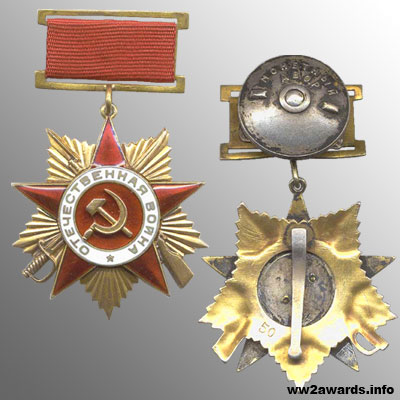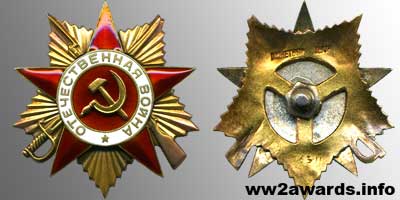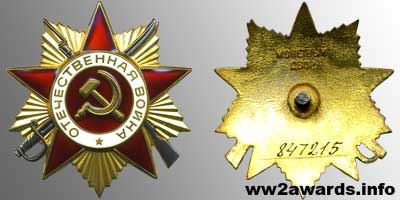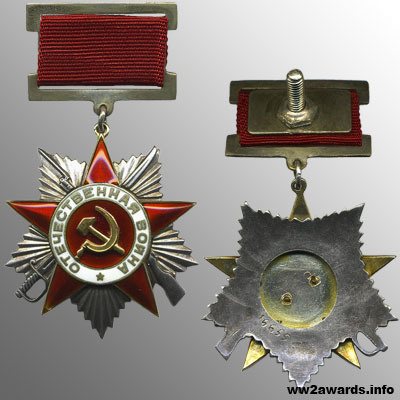Order of the Patriotic War
The Order of the Patriotic War is a Soviet military decoration that was awarded to all soldiers in the Soviet armed forces, security troops, and to partisans for heroic deeds during the German-Soviet War, known by the former Soviet Union as the Great Patriotic War.

History Order of the Patriotic War
By beginning of the Great Patriotic War, the USSR award system numbered 6 awards, but in fierce battles feats and other heroic actions were massively carried out. In addition, statute of existing awards was very vague, and did not give clear explanations for any specific actions in the combat situation to reward fighters and commanders.
In April 1942, Joseph Stalin instructed the head of Main Directorate Red Army Logistics, General Khrulev, to develop a draft order for soldiers who especially distinguished themselves in the fight against the fascist invaders. Work on project, with working title of the Order «For Military Valor», were artists Sergey Dmitriev and Alexander Kuznetsov. After the presentation first awards projects, the order was renamed, and it received its final name «Order of the Patriotic War».
The Order was established on 20 May 1942 and came in first class and second-class depending upon the merit of the deed. It featured a red enamel five-pointed star, made of silver, with straight rays in the background, and crossed sabre and rifle. The rays in the background were golden for first Class and silver for second Class. The central disc had a golden hammer and sickle on a red enamel background, surrounded by a white enamel ring with the words «ОТЕЧЕСТВЕННАЯ ВОЙНА» (Patriotic War). Originally the Order was attached to a plain red ribbon much like the Gold Star award, but from June 1943 the Order was to be worn on the right chest without ribbon; on less formal occasions a ribbon bar, dark red with a bright red central stripe for the 1st Class, or dark red with bright red edge stripes for the 2nd Class, may be worn instead. The material for order of the Patriotic War 1st class was chosen gold, 2nd-silver.
Also, a statute was drafted to the Order, which specifies exploits and combat situations for which it was awarded, for the Order of the 1st class of such combat situations there were 30, II-28. The combat situations were identical, the main difference consisted in numbers. So, for example, for three destroyed batteries of the enemy, the Order of the Patriotic War of the 2nd class relied, for five batteries destroyed - the first class, or «The one who evacuated from the battlefield 2 tanks under the enemy fire» received the order of the second class, three evacuated tanks were handed over already the Order of the Patriotic War of the first class.
To timely reward fighters and commanders who distinguished themselves in battles, the right to award over the Order of the Patriotic War was transferred to military command - from commanders of fronts and fleets to corps commanders inclusive. The awarding of orders often took place in a combat situation immediately after the performance of the feat.
List of recipients Order of the Patriotic War
The first awards took place in May 1942. Awarded were the artillerymen of the thirty-second regiment, who fought in the Kharkov direction. The calculation of Captain Ivan Cricle in two days of continuous combat could completely destroy 32 enemy tanks when part of the calculation was killed or seriously injured, Senior Sergeant Smirnov, continued to fire even after losing his hand. For their courage and heroism, as well as for implementation of norms of the statute, Cricle and Smirnov were awarded Order of the Patriotic War first class, the other fighters received orders of the second degree.
The Order of the Patriotic War of the 1st class under № 1 was received by the family of posthumously awarded Konyukhov Vasiliy Pavlovich, the senior political instructor, deputy chief of the political department of the 52nd Infantry Division, for showing courage and bravery in battles near Rzhev in 1942.
Order of the Patriotic War, 2nd class №1, was posthumously awarded Pavel Alekseevich Razhkin, a senior lieutenant, deputy chief of staff for for intelligence 155th Tank Brigade, who many times personally supervised the operations, sometimes reconnoitering a battle on tanks.
There were cases when the Order of the first class was awarded to all the soldiers who participated in the military operation, for the first time such honor was given to the sailors of the submarine K21, for the attack on the flagship`s battleship of the German fleet, Kirpitz.
Many Soviet soldiers and officers were awarded the Order of the Patriotic War more than once. The maximum known number of awards for one person by this order, for feats during the war years - five times. This cavalier Fedorov Ivan Evgrafovich, four Orders of the Patriotic War I class (3 combat and 1 anniversary) and one Order of the Order II class.
Also, many Orders of the Patriotic War were awarded to foreigners, mostly in the ranks of the Polish army, the French Normandy-Neman aviation regiment, the Czechoslovak corps, the crews of the Lend-Lease ships.
After the war, the Order of the Patriotic War was awarded to tens of thousands of wounded soldiers, who for whatever reason, did not receive the rewards to which they were presented during the fighting.
In 1985, in honor of the 40th anniversary of the Great Victory over Fascism, the Order of the Patriotic War all veterans of the war who lived at that time were awarded.
All in all approximately was produced awards: the Order of the Patriotic War 1st class - 344000, 2nd class - 1028000. The jubilee Patriotic War 1st class - 2054000, 2 class - 5408000.
Order of the Patriotic War in the award system of the USSR
Prices for Order of the Patriotic War
To date, prices for the Order of the Patriotic War start from:
Order of the Patriotic War 1 class
1942-43 Type 1 ribbon block ≈23100 pcs. - 1000 $
1943-91 Type 2 screw fastening ≈320000 pcs. - 200 $
1985 Type 3 Anniversary ≈2500000 pcs. - 10 $
Order of the Patriotic War 2 class
1942-43 Type 1 ribbon block ≈32200 pcs. - 500 $
1943-91 Type 2 screw fastening ≈900000 pcs. - 50 $
1985 Type 3 Anniversary ≈5500000 pcs. - 8 $
The price has been updated on: 15.10.2025 yr.
Varieties of the Order of the Patriotic War I class
Type 1 «Ribbon block»

Number: 1-23920
Weight without ribbon block: 32.5±1.5 g. Width 48.0-51.1 mm. Size ribbon block 32*18 or 32*21.5 mm.
The first type of the Order of the Patriotic War was suspended, on a rectangular ribbon block, covered with a red moire ribbon and was made from its establishment on May 20, 1942.
All the signs of the first type were made at the Krasnokamsk Mint (KMD). Order consisted of four parts:
1) outer, silver five-pointed star with a circle in the center, covered with red and white enamel and the inscription «ОТЕЧЕСТВЕННАЯ ВОЙНА» (PATRIOTIC WAR) around the circle, was made of 925 silver;
2) inner gold star, made of 583 gold, in the form of divergent rays, with crossed sword and rifle;
3) golden hammer and sickle, imposed on the central part order;
4) a rectangular block, covered with a red ribbon with a threaded pin and a nut on the reverse side.
On the reverse of the inner golden star in the center is a round hole, with a diameter of 16.5 mm, through which two rivets are visible, fastening the golden hammer and sickle to the outer star. In addition, in the early versions of the Order, on the reverse golden star, a vertical pin can be soldered, for additional attachment to clothing, in later versions, there is no pin. Order number is stamped manually, on the inner star at 7 o'clock on the dial. The fastening of the order's badge to the block can be directly through the ring at the top of the sign and the bottom of the block, and with the use of an additional ring between them.
Type 2 «Screw fastening»

Number: 23970-327100
Weight 32.0±1.5 g. Weight of the golden star 14.5±0.5 g. Width 48.0-51.2 mm. Height 50,4-51,9 mm.
The appearance of the second type of order is associated with a decree of June 19, 1943, prescribing to wear all the orders in the form of a star, on the right side of the chest, on a threaded screw. As a result, the Order of the Patriotic War lost the ribbon block, and the ring on the upper ray of the star. On the reverse of the outer star, in the center, a threaded screw appeared, which was passed through the inner star, and with the help of a small nut, connected the two parts together.
The inner golden star, in the central hole, received three jumpers, joining in the center around the screw. In addition, in the upper part of the inner star there appeared the stamp «МОНЕТНЫЙ ДВОР» (MINT), in one or two lines. Occurring variants without stamp are the exception, caused by malfunctions in the technological process when making orders. The order number moved to the lower beam of the golden star, and was applied with a engraver.
Type 3 «Anniversary»

Number: 451000- 2627900
Weight 27,0±1,5 g. Width 43.5-45,0 mm. Height 45,0-46,9 mm.
The appearance of the third type of order is connected with the Decree of the Presidium of the Supreme Soviet of the USSR of March 11, 1985, according to which in honor of the 40th anniversary of the Great Victory over Fascism, the Order of the Patriotic War all veterans of the war who lived at that time were awarded.
The third type of the order was completely made of 925 silver, in the form of a single-piece design, with no overlaid parts, with a gilded inner star, a sickle and a hammer. Unlike the second type, one of the gilded rays of the inner star comes under the hilt of the checkers. The reverse of the award was flat, with rough edges, a threaded screw and a 33 mm diameter nut. The stamp «МОНЕТНЫЙ ДВОР» (MINT) is located in the upper part of the order and is made in convex letters. Order number engraved boron car or engraver, has an underscore and is located below the rifled screw.
Moscow and Leningrad Mints, Russian Gems, Moscow, Bronnitsy and Tallinn Jewelry Plants were engaged in the manufacture of the orders of the Patriotic War of the 1st class of the third type.
Varieties of the Order of the Patriotic War II class
Type 1 «Ribbon block»

Number: 1- 61450
Weight without ribbon block: 28,05±1,5 g. Width 43,5-45,0 mm. Size ribbon block 32*18 or 32*21.5 mm.
Similarly to the 1st class of the Order, the 1st type was made of four parts: the outer star; the inner star; a gold sickle and a hammer: ribbon block. Manufacturers were the Krasnokamsky Mint (КМД) and the Moscow Mint (ММД).
The difference from 1 class was that the inner star was made not from gold, but from silver of 925 tests. Most often, the inner and outer stars are connected by soldering, although Moscow Mint variants are encountered where the inner and outer star can be connected by means of rivets. Early versions of the order have a vertical pin on the reverse, for additional attachment to clothing. In addition, the first versions of the order were fastened directly to the ribbon block, through a ring extending from the upper beam, in later versions, an additional ring was inserted between the ribbon block and the order.
Type 2 «Screw fastening»

Number: 34787-985700
Weight 24,6-28,1 g. Width 43,4-45,0 mm, Height 45,2-46,7 mm.
The second type of the Order of the Patriotic War appeared after the decree of June 19, 1943, according to which this award was now worn on the right side of the chest, on a screw fastening. The mark lost its ribbon block and eyelet on the upper ray, and also received a threaded screw on the reverse.
Signs of the second type were made of two parts, directly the sign itself, made of silver, in which now the inner and outer stars were made as a whole, and the gold sickle and hammer, fastened by means of two rivets.
Manufacture of orders of the second type was carried out: Krasnokamsky Mint; Leningrad Mint; Moscow Mint and Moscow plant «Platinapribor». As a result of the order of different manufacturers and different years, they have dozens of minor differences, on variants of execution of the reverse of the award, the imprinting of the mint and the order number.
Type 3 «Anniversary»

Number: 985701- 6715100
Weight: 26,5-27,5 g. Width 44,4-45,0 mm, Height 46,2-46,9 mm.
The third type of order appeared in connection with the Decree of the Presidium of the Supreme Soviet of the USSR of March 11, 1985, which in connection with the 40th anniversary of the victory in the Great Patriotic War, provided for the awarding of all veterans living at that time.
The third type of order was entirely made of silver, without overhead details, with a gold-plated sickle and hammer. The reverse of the award is flat, with rough edges, without rivets. Stamp is convex, located above the rifled screw, in two lines. The order number is located below the screw, engraved boron machine or engraver and underlined by one stripe.
The award was made at the following factories: Moscow Mint; Leningrad Mint; Tallinn Jewelry Factory; Moscow Jewelry Factory; Sverdlovsk Jewelry Factory; Riga Jewelry Factory; Bronnitsky jewelry factory; Mstery plant Jeweler; Leningrad Production Association Russian Gems and Kaliningrad Amber Plant.
Statute of the Order of the Patriotic War
Order of the Patriotic war I class is awarded
- Who accurately amazed and destroyed a particularly important object in the enemy`s rear;
- Who bravely fulfilled his duties in airplane crew in performance of the combat mission, for which navigator or pilot was awarded Order of Lenin;
- Who shot down in an air battle, being part of the crew:
heavy-bomber aviation - 4 aircraft;
long-range-bomber aviation - 5 aircraft;
short-range-bomber aviation - 7 aircraft;
assault aviation - 3 aircraft;
fighter aircraft - 3 aircraft. - Who has committed, as part of the crew:
heavy-bomber aviation - the 20th successful-combat mission;
long-bomber aviation - 25th successful-combat mission;
short-range-bomber aviation - 30th successful-combat mission;
assault aviation - 25th successful-combat mission;
fighter aircraft - 60th successful-combat mission;
long-range reconnaissance aircraft - 25th successful-combat mission;
short-range reconnaissance aircraft - 30th successful-combat mission;
correction aviation - 15th successful-combat mission;
communication aircraft - the 60th successfully-combat mission with a landing on its territory and the 30th successful-combat mission with a landing near the location of its troops in the territory occupied by the enemy;
transport aviation - the 60th successfully-combat mission with a landing on its territory and the 15th successful-combat mission with a landing near the location of its troops in the territory occupied by the enemy. - Who organized the clear and uninterrupted management of aviation units;
- Who organized the clear and systematic work of the headquarters;
- Who was able to repair damaged aircraft that made an emergency landing on territory of the enemy, and release it into the air;
- Who managed to restore at least 10 aircraft at an advanced airfield under enemy fire;
- Who, under the enemy's fire, managed to take all supplies from the airfield and, having mined it, prevented the enemy from landing on it;
- Who personally destroyed 2 heavy or medium, or 3 light tanks (armored cars) of the enemy, or as part of the gun crew - 3 heavy or medium, or 5 light tanks (armored cars) of the enemy;
- Who suppressed at least 5 enemy batteries with artillery fire;
- Who destroyed at least 3 enemy aircraft with artillery fire;
- Who, consisting of the tank crew, successfully carried out 3 combat missions to destroy firepower and manpower of enemy or destroyed in battle at least 4 enemy tanks or 4 guns;
- Who under enemy fire evacuated from the battlefield at least 3 tanks, knocked down by the enemy;
- Who, despising the danger, was the first to break into the bunker (trench or dugout) of the enemy, decisive action destroyed his garrison, and gave our troops the opportunity to quickly capture this line;
- Who under the enemy`s fire created the bridge, corrected the bridge, destroyed by the enemy; who under the enemy`s fire, on the instructions of the command, personally blew up the bridge or ferry to detain the enemy`s movement;
- Who has established technical or personal communication under the enemy fire, fixed the technical means of communication destroyed by the enemy, and thereby ensured the continuity of control over the combat actions of our troops;
- Who, during the battle, personally threw the cannon (battery) into an open position and shot the advancing enemy and his equipment at point-blank range;
- Who, commanding a part or subdivision, destroyed the superior force of the enemy;
- Who, participating in the cavalry raid, cut into the enemy group and destroyed it;
- Who with the battle captured the enemy`s artillery battery;
- Who, as a result of personal reconnaissance, established the enemy's weak defenses and led our troops to the rear of the enemy;
- Who, entering the crew of a ship, aircraft or combat calculation of a coastal battery, drowned a warship or two enemy vehicles;
- Who organized and successfully landed the sea assault in the territory of the enemy;
- Who is under the fire of the enemy withdrew from the fight her damaged ship;
- Who captured and brought into his base the enemy`s battle ship;
- Who successfully carried out the minefield on approaches to enemy bases;
- Those who repeatedly trawled successfully ensured the combat activity of the fleet;
- Who successfully eliminated the damage in battle ensured the restoration of the ship's combat capability or the return of the damaged ship to the base;
- Who perfectly organized the logistics of the operation of our troops, which contributed to the defeat of the enemy.
Order of the Patriotic war II class is awarded
- Who bravely fulfilled his duties in the crew of the aircraft during the performance of the combat mission, for which the navigator or the pilot was awarded the Order of the Red Banner;
- Who shot down in an air battle, being part of the crew:
heavy-bomber aviation - 3 aircraft;
long-range bomber aircraft - 4 aircraft;
short-range bomber aircraft - 6 aircraft;
assault aviation - 2 aircraft;
fighter aircraft - 2 aircraft. - Who made, entering the crew:
heavy-bomber aviation - 15th successful-combat mission;
long-bomber aviation - the 20th successful-combat mission;
short-range bomber aviation - 25th successful-combat mission;
assault aviation - the 20th successful-combat mission;
fighter aircraft - 50th successful-combat mission;
long-range reconnaissance aircraft - the 20th successful-combat mission;
short-range reconnaissance aircraft - 25th successful-combat mission;
corrective aviation - the 10th successful combat mission;
aviation communications - the 50th successful combat mission with a landing on its territory and the 20th successful combat mission with a landing near the location of its troops in the territory occupied by the enemy;
transport aviation - the 50th successful combat mission with a landing on its territory and the 10th successful combat mission with a landing near the location of its troops in the territory occupied by the enemy. - Who was able to restore, master and use the captured trophy aircraft in combat conditions;
- Who was able to restore at least 5 aircraft at an advanced airfield under enemy fire;
- Who personally destroyed one heavy or medium, or two light tanks (armored cars) of the enemy, or as part of the cannon crew - 2 heavy or medium, or 3 light tanks (armored cars) of the enemy;
- Who destroyed the enemy's firepower with artillery fire or mortars, ensuring the successful actions of our troops;
- Who suppressed at least 3 enemy batteries with artillery fire or mortars;
- Who destroyed at least 2 enemy aircraft with artillery fire;
- Who with his tank destroyed at least 3 enemy firing points and thereby contributed to the advancement of our advancing infantry;
- Who, consisting of the tank crew, successfully carried out 3 combat missions to destroy the firepower and manpower of the enemy or destroyed in battle at least 3 enemy tanks or 3 guns;
- Who, under the fire of the enemy, evacuated 2 tanks from the battlefield, shot down by the enemy;
- Who with the grenades, bottles with a combustible mixture or explosive packs destroyed an enemy tank on the battlefield or in the rear of the enemy;
- Who, directing a part or subdivision surrounded by the enemy, defeated the enemy, brought out his unit (unit) from the surrounded without loss of weapons and military property;
- Who got to the firing positions of the enemy and destroyed at least one gun, three mortars or three machine guns of the enemy;
- Who at night took off the guard post (patrol, secret) of the enemy or captured him;
- Who from the personal weapon has brought down one plane of the opponent;
- Who, struggling with superior enemy forces, did not pass any of his positions and caused great damage to the enemy;
- Who organized and maintained in complex combat conditions the continuous communication of the command with the troops conducting the battle, and thereby contributed to the success of the operation of our troops;
- Who, when entering the crew of a ship, aircraft or combat calculation of a coastal battery, put out of action or damaged a warship or one enemy transport;
- Who captured and brought to its base enemy transport;
- Who timely detection of the enemy prevented the attack on ship, the base;
- Who ensured the successful maneuvering of the ship, as a result of which the enemy ship was drowned or damaged;
- Who with skilful and precise work ensured successful combat work of the ship (combat unit);
- Who organized the uninterrupted logistical support of part, unit, army and thereby contributed to success of unit, connection.
Awarding of the Order of the Patriotic War can be repeated for new feats and distinctions.
Order of the Patriotic War I class worn awarded on the right side of the chest and is located after the Order of Alexander Nevsky.
The Order of the Patriotic War II class worn on the right side of the chest and is located after the Order of the Patriotic War I class.
Updated: 2025-10-15 03:49:59